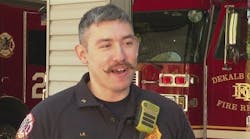How do we get killed when using our own apparatus? Some of the most common reasons are:
- Firefighters not wearing seatbelts prior to an accident or unexpected vehicle movement.
- Apparatus crashes resulting in death or injury due to the crash and often due to the above – not wearing seatbelts.
- Apparatus backing up and hitting, crushing or running over firefighters.
As far as the seatbelt issue is concerned, we conducted an extremely in-depth and not-so-scientific study and evaluation. After hours of research and study, we came to the following solution for the problem: Wear your seatbelt! Officers, don’t even think about allowing the vehicle to move until you are belted in. Apparatus drivers, same thing. And now that you are both belted in, do not budge the apparatus until everyone is belted in.
What if they don’t belt in? Don’t move the apparatus. If they get hurt, you will be held responsible. Want to see firefighters put their belts on? Tell them that “we aren’t going to leave for this fire until you do.” Some firefighters claim they can’t don their SCBA while belted in – then have them wait until they get to the fire.
Officers, you are officers all the time, not just when “crawling down the hallway.” Enforce the seatbelt policy so you won’t have to explain to some kid why his or her Dad was tossed through a windshield because his seatbelt was not on. Are you fully responsible? Yes, but so are the firefighters, who must also take personal responsibility to take care of themselves.
Some fire departments are now specifying “Seatbelt Assurance Systems” to assure that no fire apparatus is delivered without a system that helps manage the problem of members being seatbelted. Sometimes, “mechanical solutions” work better than the human solutions. One department has made “not wearing a seatbelt when any fire department apparatus is moving” a “two-hit offense.” What does that mean? It means that the failure to wear your seatbelt the first time will cost you time off and the second time you get caught will make you a former firefighter. Does that chief care too much? It’s a matter of priorities.
Apparatus crashes continue to also be a problem. What is the solution? Aggressive driver training programs that will not allow someone to become “qualified” without becoming an expert is one solution. For years, apparatus training has focused on pump pressures and ladder placement. Those are important, but only recently has driver training become a more serious issue. Why? Because we keep crashing. Why do we crash? Answers include failure to use caution while driving, failure to stop at red lights, failure to stop at stop signs and failure of the officer to enforce apparatus-driving policies.
What about the legal status of your apparatus drivers? Are their drivers’ licenses valid? How do you know?
Another issue that keeps raising its head is the condition of apparatus drivers. Are the drivers of your fire department vehicles drunk or high? How do you know? What “systems” are in place to keep drunks from getting behind the wheel of apparatus? What policies exist and what training have your officers been given to manage this issue? This is not an easy issue to deal with and requires significant training and clear policies.
Then there is the issue of apparatus backing over and running over firefighters. One Maryland fire department recently investigated an accident involving some of its members. Reports were that a member who was behind a piece of apparatus as it was backing up into the bay got an arm trapped between the vehicle and a “fixed object.” The member was hospitalized and the arm injury required surgery. The initial reports were that safety protocols were in place. The intent of the backer was to communicate to the driver to stop, but when the injury occurred the driver may not have known to stop. Inexperience, tight quarters and the backer simply not paying attention were reported to have led to this unfortunate outcome.
As an Ohio fire department’s apparatus was backing into quarters, the department’s backing policy was not being followed by the officer or the crew members. Predictably, the vehicle hit the building. Following an investigation, the officer, the driver and the firefighter were all disciplined. The rules existed, they were broken and the fire department took corrective action. Isn’t that how it is supposed to work? What if that fire department had not enforced the policy? When that happens, you might as well throw the policies out.
In California, a rookie firefighter was fatally injured after being struck by the apparatus to which she was assigned. The firefighter was standing on the rear of the truck as it backed up slowly following a fire call. The preliminary report states that the firefighter fell or dismounted from the apparatus tailboard. She was in position as “the tailboard safety member” who was using the bell system to help the engineer back up. Additionally, there was a fire commander on the street personally directing the backing operation and functioning as the traffic control officer. The driver heard the “three bells” (to back up) that were signaled from the firefighter who was on the tailboard and the rig moved backwards at approximately 2.5 mph.
Within a few moments, the commander turned away from the apparatus toward an intersection to control cross traffic. The driver had visual contact with the commander in the driver’s-side mirror and was anticipating directions to stop or slow for the cross traffic. Shortly thereafter, the commander turned and observed that the firefighter was no longer on the tailboard. Following immediate investigation, the commander found the firefighter lying in front of the apparatus. The engineer was immediately told to stop and at this time, the engineer also saw the firefighter come in view through the front windshield. No “one bell” stop signal was reported to have been heard.
In Pennsylvania, a veteran firefighter was recently killed and another firefighter was injured when the brand-new apparatus they were looking at (they were standing on the ground, right at the tailboard) backed over them in the driveway to the fire station. The injured firefighter was able to pull himself out and away quickly, but the firefighter who was killed was found face down in the gravel behind the truck with a camera nearby, witnesses said.
Backing accidents are not new; firefighters have been killed and injured this way before. But what about the thousands of times when no one is hurt and “just the building” or “just the bay door” is struck? It easily could be another firefighter tragically killed.
What’s the solution? While not at all referring specifically to these recent events, fire departments need tough (and enforced) driving, backing and other safety-related policies that require training and an effort by all crew members to follow all stated policies – with clear and severe consequences if this is not done. Most importantly, fire departments need tough officers who are not afraid to strictly enforce the important rules, the ones that prevent us from getting hurt or killed. Naturally, firefighters must have “self-survival discipline” to take some very simple and basic steps so we reduce and eventually eliminate these needless losses.
Clear, written and trained-upon policies + educated firefighters who respect and understand the policies + officers who have the courage to enforce these policies = significant reduction of injury and death of firefighters.
William Goldfeder, EFO, a Firehouse® contributing editor, is a 31-year veteran of the fire service. He is a battalion chief with the Loveland-Symmes Fire Department in Ohio, an ISO Class 2 and CAAS-accredited department. Goldfeder has been a chief officer since 1982 and has served on numerous IAFC and NFPA committees, and is a past commissioner with the Commission on Fire Accreditation International. He is a graduate of the Executive Fire Officer Program at the National Fire Academy and is an active writer, speaker and instructor on fire service operational issues. Goldfeder and Gordon Graham host the free and noncommercial firefighter safety & survival website www.FirefighterCloseCalls.com. Goldfeder may be contacted at [email protected].





